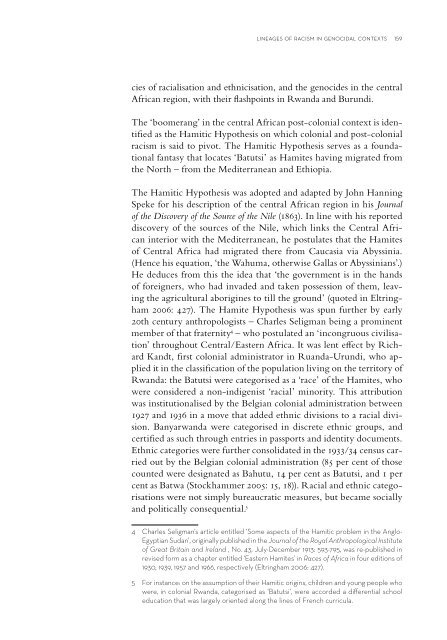60 years after the UN Convention - Dag Hammarskjöld Foundation
60 years after the UN Convention - Dag Hammarskjöld Foundation
60 years after the UN Convention - Dag Hammarskjöld Foundation
You also want an ePaper? Increase the reach of your titles
YUMPU automatically turns print PDFs into web optimized ePapers that Google loves.
lineages of racism in genocidal contexts 159<br />
cies of racialisation and ethnicisation, and <strong>the</strong> genocides in <strong>the</strong> central<br />
African region, with <strong>the</strong>ir fl ashpoints in Rwanda and Burundi.<br />
The ‘boomerang’ in <strong>the</strong> central African post-colonial context is identifi<br />
ed as <strong>the</strong> Hamitic Hypo<strong>the</strong>sis on which colonial and post-colonial<br />
racism is said to pivot. The Hamitic Hypo<strong>the</strong>sis serves as a foundational<br />
fantasy that locates ‘Batutsi’ as Hamites having migrated from<br />
<strong>the</strong> North – from <strong>the</strong> Mediterranean and Ethiopia.<br />
The Hamitic Hypo<strong>the</strong>sis was adopted and adapted by John Hanning<br />
Speke for his description of <strong>the</strong> central African region in his Journal<br />
of <strong>the</strong> Discovery of <strong>the</strong> Source of <strong>the</strong> Nile (1863). In line with his reported<br />
discovery of <strong>the</strong> sources of <strong>the</strong> Nile, which links <strong>the</strong> Central African<br />
interior with <strong>the</strong> Mediterranean, he postulates that <strong>the</strong> Hamites<br />
of Central Africa had migrated <strong>the</strong>re from Caucasia via Abyssinia.<br />
(Hence his equation, ‘<strong>the</strong> Wahuma, o<strong>the</strong>rwise Gallas or Abyssinians’.)<br />
He deduces from this <strong>the</strong> idea that ‘<strong>the</strong> government is in <strong>the</strong> hands<br />
of foreigners, who had invaded and taken possession of <strong>the</strong>m, leaving<br />
<strong>the</strong> agricultural aborigines to till <strong>the</strong> ground’ (quoted in Eltringham<br />
2006: 427). The Hamite Hypo<strong>the</strong>sis was spun fur<strong>the</strong>r by early<br />
20th century anthropologists – Charles Seligman being a prominent<br />
member of that fraternity 4 – who postulated an ‘incongruous civilisation’<br />
throughout Central/Eastern Africa. It was lent eff ect by Richard<br />
Kandt, fi rst colonial administrator in Ruanda-Urundi, who applied<br />
it in <strong>the</strong> classifi cation of <strong>the</strong> population living on <strong>the</strong> territory of<br />
Rwanda: <strong>the</strong> Batutsi were categorised as a ‘race’ of <strong>the</strong> Hamites, who<br />
were considered a non-indigenist ‘racial’ minority. This attribution<br />
was institutionalised by <strong>the</strong> Belgian colonial administration between<br />
1927 and 1936 in a move that added ethnic divisions to a racial division.<br />
Banyarwanda were categorised in discrete ethnic groups, and<br />
certifi ed as such through entries in passports and identity documents.<br />
Ethnic categories were fur<strong>the</strong>r consolidated in <strong>the</strong> 1933/34 census carried<br />
out by <strong>the</strong> Belgian colonial administration (85 per cent of those<br />
counted were designated as Bahutu, 14 per cent as Batutsi, and 1 per<br />
cent as Batwa (Stockhammer 2005: 15, 18)). Racial and ethnic categorisations<br />
were not simply bureaucratic measures, but became socially<br />
and politically consequential. 5<br />
4 Charles Seligman’s article entitled ‘Some aspects of <strong>the</strong> Hamitic problem in <strong>the</strong> Anglo-<br />
Egyptian Sudan’, originally published in <strong>the</strong> Journal of <strong>the</strong> Royal Anthropological Institute<br />
of Great Britain and Ireland , No. 43, July-December 1913: 593-795, was re-published in<br />
revised form as a chapter entitled ‘Eastern Hamites’ in Races of Africa in four editions of<br />
1930, 1939, 1957 and 1966, respectively (Eltringham 2006: 427).<br />
5 For instance: on <strong>the</strong> assumption of <strong>the</strong>ir Hamitic origins, children and young people who<br />
were, in colonial Rwanda, categorised as ‘Batutsi’, were accorded a diff erential school<br />
education that was largely oriented along <strong>the</strong> lines of French curricula.

















